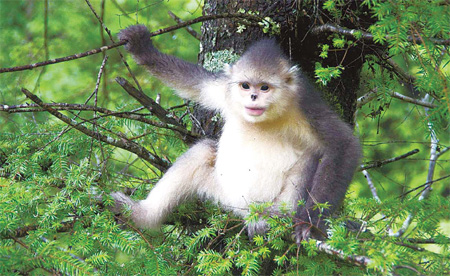Rare sightings
Surviving muddy mountain routes, dizzying altitudes, raging rivers and landslides, D J Clark finally spots the endangered snow monkey deep in the forests of northern Yunnan.
 |
|
The Yunnan snow monkey in the hills above Tacheng in north central Yunnan. |
"It will be four weeks of rough terrain and steep mountains in the far reaches of China, are you interested?" British adventure writer Simon Chapman asked me last January. He had been researching a rare monkey he wanted to base a new book on, and was planning a trip to Yunnan in western China. I had accompanied Chapman through the Amazon and along the Armu River in Siberia on previous adventures and I knew this was going to be a tough assignment. Up until the early 1960s it had been thought that the Yunnan snow monkey was extinct but recent surveys have found around 15,000 of them living in a few isolated forests high in the mountains of northern Yunnan.
Also referred to as the Yunnan snub-nosed monkey because of their thick lips and squashed nose, the endangered animal can survive freezing temperatures at higher altitudes than any other primate.
The Lisu ethnic group that lives in the area regard them as ancient ancestors that figure prominently in their folklore. Finding them in the wild is not easy, as the mountains they live in are remote and difficult to navigate.
Chapman's plan was to start at the southern point of the Gaoligong Mountain range, which runs along the Myanmar border, and head north toward the Tibet autonomous region. I invited Liu Weidong, an experienced mountaineer from Beijing, to help with the logistics and at the end of July we all met in Kunming, backpacks loaded.
Riding a small minivan from the city of Baoshan toward the foothills of Gaoligong Mountain is a sharp wake up call from the relative order of Beijing.
The wet muddy route meanders through deep walled valleys, occasionally crossing rivers on thin metal bridges. At crossings without bridges, local villagers glide across the rivers carrying their goods to and from the market, on zip lines strung above the raging waters. Four months of the year, from May to August, the area has daily downpours as monsoon rains from the Indian Ocean funnel up the steep gorges that run in parallel through the province from north to south.
Just 4 km short of our destination, a landslide blocked our path and we left the van to complete the journey on foot.
 0
0 



![A team photograph of, from left to right, Simon Chapman, D J Clark and Liu Weidong. English explorer Simon Chapman led an expedition this summer that traversed the Gaoligong National Nature Reserve in search of the Yunnan snow monkey. [D J Clark / China Daily] A team photograph of, from left to right, Simon Chapman, D J Clark and Liu Weidong. English explorer Simon Chapman led an expedition this summer that traversed the Gaoligong National Nature Reserve in search of the Yunnan snow monkey. [D J Clark / China Daily]](http://images.china.cn/attachement/jpg/site1007/20100926/0014222d98500e09327226.jpg)




Go to Forum >>0 Comments